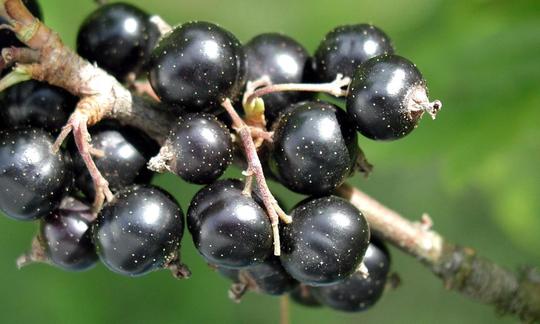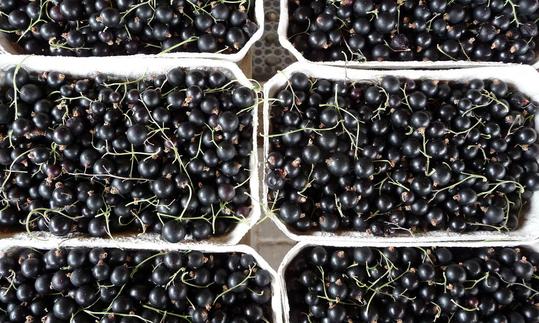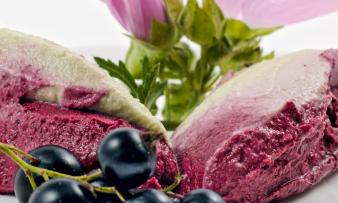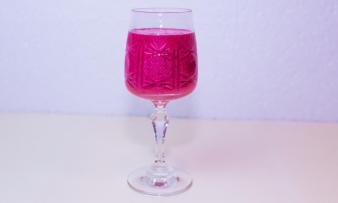Table of contents
Blackcurrants ( Ribes nigrum), also known as black currants or cassis, can be eaten raw and pure, but the vitamin C-rich berries are often processed into juice or jam. Organic quality is preferable.
Use in the kitchen
Blackcurrants, also known as black currants or cassis, are, as the name suggests, berries with deep purple to black tones. In addition to their sweet and sour taste, they also have a tart, slightly bitter and astringent aroma, which is why cassis products often contain a lot of sugar. 4 Some people find the plant's peculiar smell unpleasant, some describe it as "bug-like". However, this smell largely disappears after the leaves are dried and the berries are cooked. 5
Can you eat blackcurrants raw? Although you can eat blackcurrants raw, they are mainly processed into juice, syrup (cassis syrup), sorbet or chutneys. The black berries are also a treat in vegan desserts. On cakes and pastries, but also in smoothies (e.g. in berry shake with wheat germ) or a mousse (e.g. in blackcurrant mousse with coconut and mallow blossoms), the berries taste particularly refreshing and give a beautiful color. They add variety to muesli, e.g. in pea muesli, or as a topping on raw vegetable salads. For milder variants, use the slightly smaller red or white currants, which are also often eaten raw.
Like all currants, black currants are also suitable for making jams or jellies. Do black currants have a lot of pectin? The high pectin content of black currants means that preservatives can be omitted and the amount of sugar can be significantly reduced. The citric acid they contain gives them a fresh, sour note and acts as a natural preservative.
The famous Cassis liqueur is made from black currants. Black currants are also used for the aperitif "Kir". It consists of white wine with crème de cassis. If the cocktail is prepared with champagne, it is called "Kir Royal".
If you have too many raw blackcurrants, you can also dry them - ideally in a dehydrator. The drying times vary depending on the model of the device and the size of the fruit. In the oven at 40-50 °C (circulating air), the drying process for small berries takes around 10 hours. To allow the moisture to escape, a small gap in the oven must be left open (e.g. using a wooden spoon). For even drying, it is worth turning the berries every 2 hours. The berries can also be gently air-dried, e.g. in the attic or (in the heating season) next to the heater or fireplace. However, this can take several weeks. In this case, it is advisable to turn the berries daily to prevent mold from forming. 9
In addition to the berries, the young currant leaves can also be used in the kitchen. You can find out more about this in the related article.
Vegan recipe for chutney with blackcurrants
Ingredients: 250 g blackcurrants (raw, organic), 2 red onions, 1 pear, juice of an orange, 1 small chili pepper, 50 ml white wine vinegar, 100 g raw cane sugar, 1 teaspoon salt, 1 tablespoon rapeseed oil.
Preparation: Peel the onions and dice them. Remove the seeds from the chilli pepper and dice them too. Sauté these ingredients briefly in the oil. Deglaze with orange juice and vinegar. Then add the sugar, peeled and diced pear and currants. Add salt and simmer over a low heat for about 1 hour until the liquid has evaporated. The vegan chutney should have a viscous consistency. Stir regularly to prevent the mixture from burning. Pour the chutney into well-rinsed jars while it is still hot and store.
Tea preparation
Dried cassis berries also taste good brewed as tea. 1 tablespoon of dried berries is enough for one cup. Blackcurrant tea not only helps with colds, but is also said to have a soothing effect on rheumatism and gout.
Vegan recipes with blackcurrants can be found under the note: " Recipes that have the most of this ingredient ".
| Not only vegans or vegetarians should read this: Vegans often eat unhealthily. Avoidable nutritional errors. |
Shopping - Storage
Where can you buy blackcurrants? Supermarket chains such as Coop, Migros, Denner, Volg, Spar, Aldi, Lidl, Rewe, Edeka, Hofer and Billa and organic supermarkets (e.g. Denn's Biomarkt, Alnatura) rarely offer blackcurrants. They primarily sell redcurrants. Blackcurrants are also available in season in organic shops, at weekly markets or in fruit and vegetable subscription boxes - in Central Europe they are in season from June to August.
With fresh currants, it is important that they look plump and undamaged. If the clusters still have fresh, green leaves, it is worth buying. Before eating, sort out the mushy berries and wash the rest thoroughly. Make sure they are organic.
Cassis juice made from the black berries is often available in health food stores. Many industrially produced juices contain high amounts of sugar. If you don't make the juice yourself, buy organic products with no added sugar.
The availability of blackcurrants varies depending on the size of the store, catchment area, etc. Our recorded food prices for the DA-CH countries can be found above under the ingredient image - and by clicking on them you can see their development at various suppliers.
Found in the wild
The original distribution area of the black currant ( Ribes nigrum) extends from Europe to the Russian Far East and Central Asia. It grows mainly in the temperate climate zone. 7 In the wild, black currants are found mainly in moist forests and alder groves. 5,8,10
The plant was introduced to Austria and Switzerland, among other places. 7 In Switzerland (probably in all DA-CH countries), the species is cultivated as a berry bush or occasionally grows wild. 5,11
The plant is a 1.5-2 m tall, summer green, unpleasant smelling shrub without thorns. The 3-5 lobed leaves are serrated, have a diameter of up to 10 cm and have oil glands on the underside. Small flowers are arranged in hanging clusters, whitish to yellowish green and brownish red at the edge. The flowering period lasts from the end of April to the end of May. Spherical, smooth, black fruits/berries develop from the flowers by June/July. 5,8,10,11,12
Storage tips
If stored for too long, the anthocyanins in blackcurrants break down as they break down and combine with sugar. That's why it's best to eat them fresh. Cassis berries will last a few days in the fridge. You can also freeze them for later use. How can you preserve blackcurrants? They last a particularly long time when made into juice, jam or jelly. The loss of vitamin C during preservation is relatively low for this berry fruit. 1
Ingredients - Nutritional values - Calories
The energy content of raw blackcurrants is low at 63 kcal/100g. They are low in fat at 0.41 g/100g and protein at 1.4 g/100g. The carbohydrate content is also not particularly high at 15 g/100g. 3
Blackcurrants are rich in vitamin C, with 181 mg/100g (226% of the daily requirement). This is more than four times higher than that of red and white currants (41 mg/100g). They also contain more vitamin C than well-known sources such as red bell peppers (128 mg/100g), lemon peel (129 mg/100g) and orange peel (136 mg/100g). A slightly higher amount is found in yellow bell peppers, with 184 mg/100g. 3
100 g of black currants contain 322 mg of potassium (16% of the daily requirement). This content is comparable to that of kiwis (312 mg/100g) and American persimmons (310 mg/100g). Dried seaweed contains extremely high levels of potassium (eg kombu seaweed : 6100 mg/100g, dulse : 4684 mg/100g), but only small amounts should be consumed at a time due to the high iodine content. 3
Manganese is contained in 0.26 mg per 100 g of black currants (raw) (13% of the daily requirement). A similar amount of manganese was found in lingonberries (0.26 mg/100g) and cranberries (0.27 mg/100g). Red and white currants contain less manganese at 0.19 mg/100g. Nuts (e.g. hazelnuts : 6.2 mg/100g), whole grains (e.g. oat flakes : 3.6 mg), seeds (e.g. pine nuts : 8.8 mg/100g; pumpkin seeds : 4.5 mg) and germs (e.g. wheat germ : 13 mg/100g) have a particularly high content of the trace element. 3
The complete ingredients of black currants, the coverage of the daily requirement and comparison values with other ingredients can be found in our nutrient tables. In the article Nutrients explained you will get a detailed insight into the topic.
Health effects
Are blackcurrants healthy? According to current research, blackcurrants have great potential to improve general health, especially in diseases related to inflammation and the regulation of blood sugar levels. The plant is also said to have performance-enhancing properties in athletes and an effect against eye diseases such as glaucoma. 13
According to the German Bechterew's Disease Association, black currants are considered effective against Bechterew's disease (chronic rheumatic disease). The high vitamin C content has a positive effect on the immune system and reduces chronic inflammatory processes. Vitamin C is a radical scavenger because it neutralizes free radicals. 1
The high proportion of pectin (fiber) has a positive effect on the intestinal flora. This lowers the pH value in the intestine, which benefits beneficial intestinal bacteria such as bifidus and lactobacillus bacteria. Consequently, currants can be described as prebiotic foods. Pectin also delays the absorption of sugar, which has a positive effect on the metabolism. 1
Secondary plant substances
Many of the health effects of blackcurrants can be attributed to the secondary plant substances they contain. Our article on secondary plant substances provides an overview of the classification of substance groups, their occurrence in foods and possible effects on humans. Blackcurrants contain the following secondary plant substances, among others: 8,12,13,14,15,16
- Isoprenoids : terpenes (such as limonene, terpinene, terpineol)
- Polyphenols : phenolic acids, flavonoids (flavonols (such as rutin), anthocyanins (such as delphinidin, cyanidin), proanthocyanidins, isoquercitrin), tannins
However, it should be noted that the composition of secondary plant substances in black currants can vary depending on the variety, time of harvest and growing conditions. Therefore, quantities are only of limited use and should only be understood roughly.
Blackcurrants ( Ribes nigrum) are rich in phytochemicals with powerful antioxidant, antimicrobial and anti-inflammatory properties. 13
Blackcurrants are known for their high content of flavonoids, especially anthocyanins, which give the fruit its black-purple color. Both blackberries andblueberries have lower total anthocyanin concentrations compared to blackcurrants. 13 Anthocyanins are believed to have antioxidant, anti-inflammatory, blood sugar-lowering, and antitumor effects, among others. 13, 14 According to a 2021 study, consuming the anthocyanin-rich berry also mitigates exercise-induced muscle damage and improves functional muscle recovery. 17
The seeds are known to contain a significant amount of unsaturated fatty acids (alpha- and gamma-linolenic acid, oleic acid). 8
Dangers - Intolerances - Side effects
There are no known side effects for the fruits of the black currant. 5
Danger of confusion
The fruits of the black currant ( Ribes nigrum) could be confused with those of the common privet ( Ligustrum vulgare). Caution: This plant and its berries are poisonous. Consumption can cause nausea, vomiting, diarrhea and stomach pain. 18
Use as a recognized medicinal plant
ESCOP ( European Scientific Cooperation on Phytotherapy) and HMPC ( Committee on Herbal Medicinal Products) recognize the blackcurrant (primarily blackcurrant leaves) as a traditional herbal medicinal product.
ESCOP lists dried blackcurrant leaves as an adjuvant in the treatment of rheumatic diseases. 19
HMPC lists mild joint pain and mild urinary tract symptoms as reasons for the medicinal use of blackcurrant leaf preparations. The committee recommends the use of blackcurrant leaf medicines only in adults. 20
Folk medicine - natural medicine
In folk medicine, black currants, especially the unsweetened berry juice, are often used against coughs, whooping cough, hoarseness, sore throats, tonsillitis, acute and chronic diarrhea and for the prevention and (after) treatment of flu and colds. 5,8,10 In these cases, it is recommended to take a teaspoon or tablespoon of the juice several times a day or, in the case of hoarseness and inflammation in the mouth and throat, to gargle the juice diluted 1:1 with warm water. The juice is also used for general strengthening, against loss of appetite and for stomach and intestinal complaints. Dried black currants are also occasionally used for urinary problems. 5
Externally, cassis is said to provide relief from sore throats 6.
Blackcurrant leaves are used in Europe as a diuretic, which reduces blood volume through its diuretic effect and thus helps to lower blood pressure. They are also used to gargle for sore throats and mouth ulcers. 12
Ecological footprint - animal welfare
The CO 2 footprint of a food depends on various aspects, such as cultivation method (conventional/organic), seasonality, country of origin, transport and, if applicable, packaging. According to the Danish climate database Concito, the carbon footprint of the raw cassis berry is 0.69 kg CO 2 eq/kg. 21
According to a Dutch study from 2011, the water footprint amounts to 449 litres of water per 1 kg of currants (unspecific). 22
In conventional agriculture, synthetic insecticides and herbicides are often used to combat unwanted plants and insects. These have been proven to have a negative impact on the environment and affect important pollinators, birds and mammals. Accordingly, when buying blackcurrants, you should buy organic products in order to protect biodiversity and your own health, among other things. The use of such pesticides is prohibited in organic farming.
For detailed explanations of various sustainability indicators (such as ecological footprint, CO2 footprint, water footprint), see our article: What does the ecological footprint mean?
Worldwide occurrence - cultivation
The black currant ( Ribes nigrum) is native to temperate to cold climates in Europe, North Asia and Central Asia. 7, 13
Russia, Poland, Ukraine, the United Kingdom and Germany were the 5 main producing countries of blackcurrants in 2022 (unspecified). 23 Poland is the main exporter (80-90% of global exports) of fresh and processed blackcurrants. 13
Black currants have remained relatively unknown in the U.S. market because their cultivation was banned in the United States from the early 20th century until the 1980s. This was due to significant losses incurred by the lumber industry, which discovered that some native and non-native species of the genus Ribes can act as vectors for the fungus Cronartium ribicola, the cause of pine blister rust, a disease of pine trees that leads to the death of native pine trees important to the U.S. lumber industry. Since then, new varieties that do not act as vectors for the fungus have been bred alongside the resistant variety "Consort." 13
Growing your own
currants can be grown in your own garden. They prefer deep, moist, humus- and nutrient-rich soil in sunny to partially shaded locations. Container plants can be planted all year round, bare-root bushes after the leaves fall in autumn or before the first shoots appear in spring. 24
The black currant needs a good supply of water until the fruit ripens. A layer of mulch can help to keep the soil moist in summer. Fertilize every three years in spring - ideally with organic berry fertilizer. Since the black currant bush is a vigorous grower, it must be cut back relatively generously. Only the five strongest shoots are left - these are cut back by about half. 24
The berries are ready for harvest between June and July. Currants harvested later taste sweeter. Early berries have a higher pectin content and are therefore particularly suitable for making jelly or jam. 24
Further information
The black currant ( Ribes nigrum) belongs botanically to the gooseberry family (Grossulariaceae), but has no thorns.
Alternative names
Black currants are also called black currants and cassis. Other names for the black currant include Ahlbeere, Alpenbeere, Bocksbeere, Gichtbeere/Gichtstock, Salbeere, Schwarze Zeitbeere, Stinkstrauch, Wanzenbeere, Vogeltrauben, Schwarze Träuble, Kanstraube and Meertrübeli.
The English name is blackcurrant or black currant.
The drug name for the fruits of the black currant is Ribis nigri fructus (formerly Fructus ribis nigri), and that for the leaves is Ribis nigri folium (formerly Folia ribis nigri). 5
Other uses
Blackcurrants can be used industrially to produce natural pigments that can be used as food additives. Blackcurrants are also used in the cosmetics industry because they are able to activate the estradiol cycle and reduce the appearance of wrinkles on the skin. 13
The seeds have a high content of gamma-linolenic acid, which is also interesting for the cosmetics industry. 6
Bibliography - 23 Sources (Link to the evidence)
| 1. | Lind-Albrecht G. Nahrungsmittel Steckbrief Johannisbeere. 2014. Deutsche Vereinigung Morbus Bechterew e.V. Bundesverband. Morbus Bechterew Journal 137. |
| 3. | USDA United States Department of Agriculture. |
| 4. | Cortez RE, Gonzalez de Mejia E. Blackcurrants (Ribes nigrum): a review on chemistry, processing, and health benefits. J Food Sci. 2019;84(9):2387-2401. |
| 5. | Pahlow M. Das grosse Buch der Heilpflanzen. Gesund durch die Heilkräfte der Natur. Nikol Verlagsges. mbH: Litauen; 2013: 174-175. |
| 6. | Bown D. The Royal Horticultural Society. Encyclopedia of Herbs & their Uses. Dorling Kindersley: London; 1995: 341. |
| 7. | Royal Botanical Garden Kew. Plants of the World Online. Ribes nigrum L. |
| 8. | Fleischhauer SG, Guthmann J, Spiegelberger R. Enzyklopädie Essbare Wildpflanzen. 2000 Pflanzen Mitteleuropas. AT Verlag: Aarau; 2013: 144-145. |
| 9. | Smarticular net: Getrocknete Beeren - lecker, vitaminreich und lange haltbar. |
| 10. | Mabey R. essbar: Wildpflanzen, Pilze, Muscheln für die Naturküche. Bern: Haupt Verlag; 2013: 172-173. |
| 11. | Infoflora ch: Ribes nigrum L. |
| 12. | Chevallier A. Das grosse Lexikon der Heilpflanzen. Dorling Kindersley Verlag GmbH: München; 2017: 262. |
| 13. | Cortez RE, Gonzalez de Mejia E. Blackcurrants (Ribes nigrum): a review on chemistry, processing, and health benefits. J Food Sci. 2019;84(9):2387-2401. |
| 14. | Zhou Y, Li Y et al. Dietary natural products for prevention and treatment of liver cancer. Nutrients. 2016;8(3):156. |
| 15. | Staszowska-Karkut M, Materska M. Phenolic composition, mineral content, and beneficial bioactivities of leaf extracts from black currant (Ribes nigrum L.), raspberry (Rubus idaeus), and aronia (Aronia melanocarpa). Nutrients. 2020;12(2):463. |
| 16. | Varming C, Andersen ML, Poll L. Volatile monoterpenes in black currant (Ribes nigrum L.) juice: effects of heating and enzymatic treatment by beta-glucosidase. J Agric Food Chem. 2006;54(6):2298-2302. |
| 17. | Hunt JEA, Coelho MOC, Buxton S, et al. Consumption of new zealand blackcurrant extract improves recovery from exercise-induced muscle damage in non-resistance trained men and women: a double-blind randomised trial. Nutrients. 2021;13(8):2875. |
| 18. | NABU Landesverband Bremen: Liguster. |
| 19. | |
| 20. | EMA Europa eu: Ribis nigri folium - herbal medicinal product. |
| 21. | The Big Climata Database. Version 1.1. Currant, black. 2024. |
| 22. | Mekonnen MM, Hoekstra AY. The green, blue and grey water footprint of crops and derived crop products. Hydrol. Earth Syst. Sci. 2011;15:1577-1600. |
| 23. | FAOSTAT Food and Agriculture Organization of the United Nations. Currants (Production Quantity 2022). |
| 24. | Mein schöner Garten de: Schwarze Johannisbeere. 2018. |












Comments